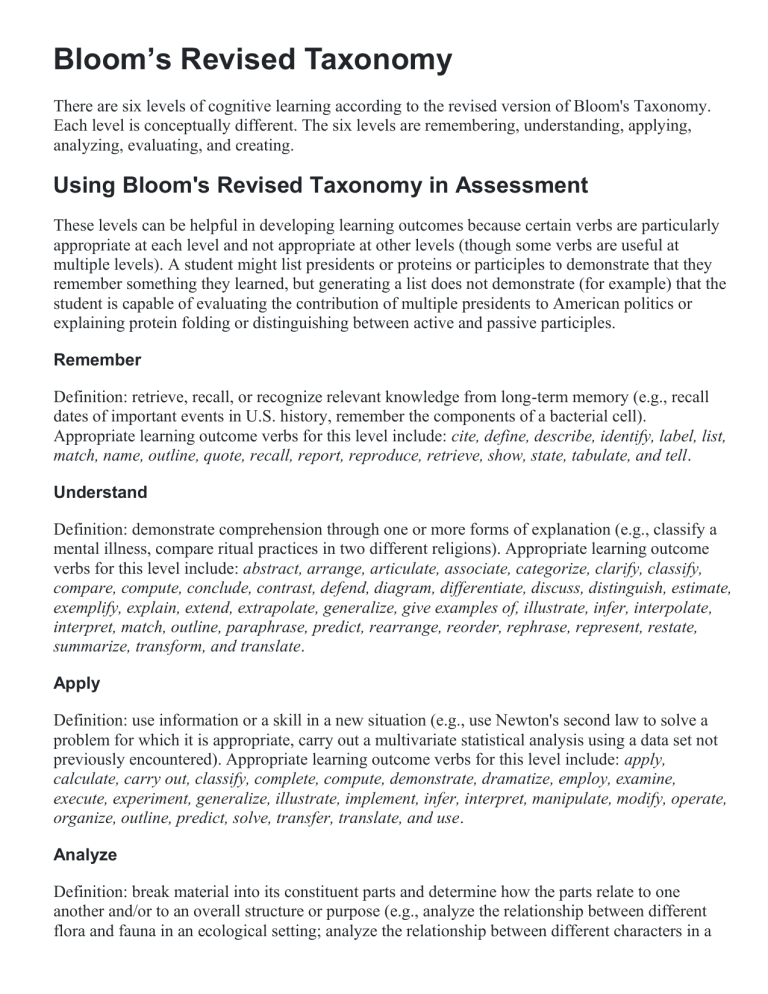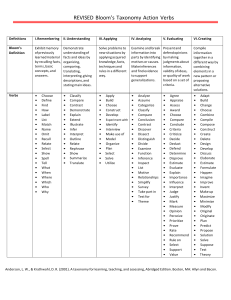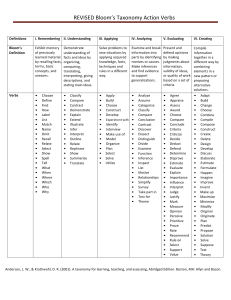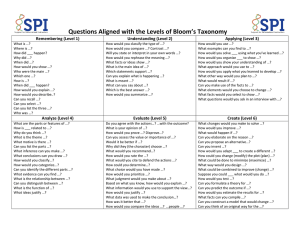
Bloom’s Revised Taxonomy There are six levels of cognitive learning according to the revised version of Bloom's Taxonomy. Each level is conceptually different. The six levels are remembering, understanding, applying, analyzing, evaluating, and creating. Using Bloom's Revised Taxonomy in Assessment These levels can be helpful in developing learning outcomes because certain verbs are particularly appropriate at each level and not appropriate at other levels (though some verbs are useful at multiple levels). A student might list presidents or proteins or participles to demonstrate that they remember something they learned, but generating a list does not demonstrate (for example) that the student is capable of evaluating the contribution of multiple presidents to American politics or explaining protein folding or distinguishing between active and passive participles. Remember Definition: retrieve, recall, or recognize relevant knowledge from long-term memory (e.g., recall dates of important events in U.S. history, remember the components of a bacterial cell). Appropriate learning outcome verbs for this level include: cite, define, describe, identify, label, list, match, name, outline, quote, recall, report, reproduce, retrieve, show, state, tabulate, and tell. Understand Definition: demonstrate comprehension through one or more forms of explanation (e.g., classify a mental illness, compare ritual practices in two different religions). Appropriate learning outcome verbs for this level include: abstract, arrange, articulate, associate, categorize, clarify, classify, compare, compute, conclude, contrast, defend, diagram, differentiate, discuss, distinguish, estimate, exemplify, explain, extend, extrapolate, generalize, give examples of, illustrate, infer, interpolate, interpret, match, outline, paraphrase, predict, rearrange, reorder, rephrase, represent, restate, summarize, transform, and translate. Apply Definition: use information or a skill in a new situation (e.g., use Newton's second law to solve a problem for which it is appropriate, carry out a multivariate statistical analysis using a data set not previously encountered). Appropriate learning outcome verbs for this level include: apply, calculate, carry out, classify, complete, compute, demonstrate, dramatize, employ, examine, execute, experiment, generalize, illustrate, implement, infer, interpret, manipulate, modify, operate, organize, outline, predict, solve, transfer, translate, and use. Analyze Definition: break material into its constituent parts and determine how the parts relate to one another and/or to an overall structure or purpose (e.g., analyze the relationship between different flora and fauna in an ecological setting; analyze the relationship between different characters in a play; analyze the relationship between different institutions in a society). Appropriate learning outcome verbs for this level include: analyze, arrange, break down, categorize, classify, compare, connect, contrast, deconstruct, detect, diagram, differentiate, discriminate, distinguish, divide, explain, identify, integrate, inventory, order, organize, relate, separate, and structure. Evaluate Definition: make judgments based on criteria and standards (e.g., detect inconsistencies or fallacies within a process or product, determine whether a scientist's conclusions follow from observed data, judge which of two methods is the way to solve a given problem, determine the quality of a product based on disciplinary criteria). Appropriate learning outcome verbs for this level include: appraise, apprise, argue, assess, compare, conclude, consider, contrast, convince, criticize, critique, decide, determine, discriminate, evaluate, grade, judge, justify, measure, rank, rate, recommend, review, score, select, standardize, support, test, and validate. Create Definitions: put elements together to form a new coherent or functional whole; reorganize elements into a new pattern or structure (design a new set for a theater production, write a thesis, develop an alternative hypothesis based on criteria, invent a product, compose a piece of music, write a play). Appropriate learning outcome verbs for this level include: arrange, assemble, build, collect, combine, compile, compose, constitute, construct, create, design, develop, devise, formulate, generate, hypothesize, integrate, invent, make, manage, modify, organize, perform, plan, prepare, produce, propose, rearrange, reconstruct, reorganize, revise, rewrite, specify, synthesize, and write. Source: Anderson, Lorin W., and David R. Krathwohl, eds. 2001. A Taxonomy for Learning, Teaching, and Assessing: A Revision of Bloom's Taxonomy of Educational Objectives. New York: Addison Wesley Longman, Inc. In 1956 Benjamin Bloom and some fellow researchers published a taxonomy of educational objectives that has been extremely influential in the research and practice of education ever since. A taxonomy is a system of classification. Bloom and his colleagues categorized objectives from simple to complex, or from factual to conceptual. These key elements are commonly known as Bloom’s taxonomy. This taxonomy defines levels of objectives in 3 domains: 1. Cognitive (knowledge based) – relating to intellectual capability i.e. knowledge or ‘think’ 2. Affective (emotive based) – relating to feelings, attitudes, values and behaviours 3. Psychomotor (action based) – relating to physical coordination and performance of physical skills The original Bloom’s Taxonomy contained six developmental categories: knowledge, comprehension, application, analysis, synthesis, and evaluation. A revised version of Bloom’s taxonomy was published by Anderson et al. in 2001. Three most prominent changes are: changing the names in the six categories from noun to verb forms rearranging them as shown in the chart below creating processes and levels of knowledge matrix Bloom’s taxonomyIt is hierarchical. Higher level learning is reliant on knowledge and skills attained at lower levels. As per revised version, the 6 levels within the Cognitive domain are: 1. Remembering: To recall, recognise, or identify concepts 2. Understanding: To comprehend meaning, explain data in own words 3. Applying: Use or apply knowledge, in practice or real life situations 4. Analysing: Interpret elements, structure relationships between individual components 5. Evaluation: Assess effectiveness of whole concepts in relation to other variables 6. Creation: Display creative thinking, develop new concepts or approaches The 5 levels within the Affective domain are: 1. Receiving: Open to experience or idea, willing to hear 2. Responding: Get involved in or participate actively 3. Valuing: Attach values and express personal opinions 4. Organising: Reconcile disparate elements or conflicts, develop value system 5. Internalising: Adopt belief system or philosophy The 5 levels within the Psychomotor domain are: 1. Imitation: Copy the actions of another, to observe and replicate 2. Manipulation: Reproduce activity from instruction or memory 3. Precision: Demonstrate activity reliably, to a high quality, and independently 4. Articulation: Integrate and adapt expertise to fulfill a non-standard objective 5. Naturalisation: Automated, unconscious mastery of activity at a strategic level In summary, Bloom’s Taxonomy is a universally effective classification strategy for educators, useful as a guide in creating educational / training content, impart learning with clear objectives, and assess learners on the learning outcomes.



